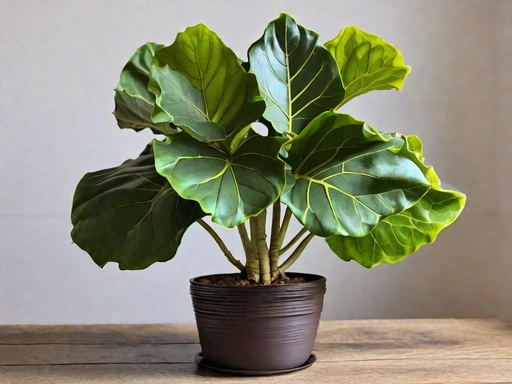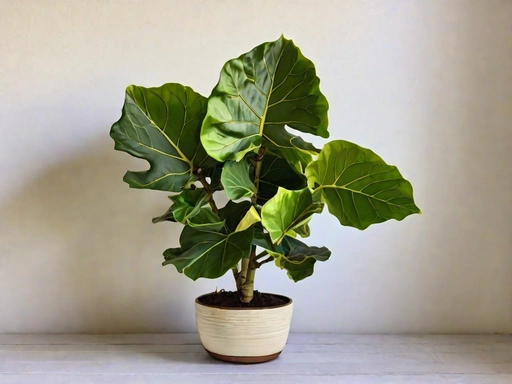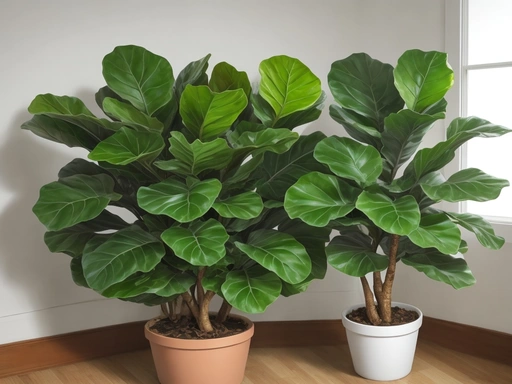Fiddle-Leaf Fig And Humidity Levels: The Perfect Environment for Your Indoor Oasis!
Key Takeaways:
- Fiddle-leaf figs prefer moderate to high humidity levels to thrive.
- Lack or excess of humidity can lead to leaf problems in fiddle-leaf figs.
- Regular misting or using a humidifier can help maintain ideal humidity for your fiddle-leaf fig.
- Monitoring humidity levels is important for maintaining the health and beauty of your fiddle-leaf fig.
Welcome to the fascinating world of fiddle-leaf fig plants and the delicate dance they have with humidity levels.
Have you ever wondered why some indoor plants thrive while others wilt away?
Well, my friend, it all comes down to understanding the needs of these beautiful green companions.
In this article, we will dive into the mysterious relationship between fiddle-leaf figs and humidity, exploring how it affects their growth and overall health.
Get ready to learn how to maintain optimal humidity levels, prevent mold and fungal growth, and unlock the secrets to keeping your fiddle-leaf fig happy and thriving.
| Humidity Level | Effect on Fiddle-leaf Fig |
| Low humidity (below 40%) | – Leaves may turn brown and start to drop – Dry air can lead to pest infestations – Growth may slow down |
| Moderate humidity (40-60%) | – Ideal range for fiddle-leaf fig – Leaves remain green and healthy – Promotes growth and overall plant health |
| High humidity (above 60%) | – Can cause fungal and bacterial diseases – Excessive moisture may lead to root rot – Leaves may become pale and wilted |
Understanding the Fiddle-Leaf Fig Plant
The fiddle-leaf fig is a popular houseplant known for its large, violin-shaped leaves.
What is a Fiddle-Leaf Fig?
A fiddle-leaf fig is a popular houseplant known for its large, glossy leaves and tree-like appearance.
It is scientifically called Ficus lyrata and is native to tropical regions of Africa.
Fiddle-leaf figs are commonly used in interior design due to their dramatic and aesthetic appeal.
They require proper care and attention to thrive indoors, including adequate lighting, watering, and humidity levels.

Popular Uses of Fiddle-Leaf Figs in Interior Design
Fiddle-leaf figs are popular in interior design for their large, vibrant leaves that make a bold statement.
They add a touch of nature and freshness to any space, whether it’s a living room, bedroom, or office.
They can be used as a focal point in a room, placed in a corner to add height, or used to fill empty spaces.
Their tall, tree-like appearance adds a sense of elegance and sophistication to any interior.
Additionally, their glossy leaves bring a sense of life and vitality to a room, creating a calming and serene atmosphere.
Whether used in minimalist or bohemian designs, fiddle-leaf figs are a versatile and stylish addition to any interior.
Caring for the Fiddle-Leaf Fig
Caring for the Fiddle-Leaf Fig is important to keep it healthy and thriving. Here are some tips:
- Watering: Water your plant when the top inch of soil feels dry. Avoid overwatering or letting the soil become waterlogged.
- Light: Place your Fiddle-Leaf Fig near a bright, indirect light source. Avoid direct sunlight as it can burn the leaves.
- Fertilizing: Use a balanced, water-soluble fertilizer during the growing season (spring and summer and reduce frequency in the winter.
- Pruning: Trim off any dead or yellow leaves to promote new growth. You can also shape your plant by pruning back unruly branches.
- Dusting: Wipe the leaves gently with a damp cloth to remove dust, which can hinder the plant’s ability to absorb light.
- Repotting: Repot your Fiddle-Leaf Fig every few years or when it outgrows its current pot. Use well-draining soil to prevent root rot.
Remember to observe your plant and adjust care based on its specific needs. With proper care, your Fiddle-Leaf Fig will be a beautiful addition to your indoor space.
The Relationship Between Fiddle-Leaf Figs and Humidity Levels
Fiddle-leaf figs are influenced by humidity levels in their environment, which can impact their growth and health.
How Do Humidity Levels Affect Fiddle-Leaf Figs?
Humidity levels can greatly impact fiddle-leaf figs.
High humidity can lead to fungal diseases, yellowing leaves, and root rot.
Low humidity can cause leaf drop, brown edges, and dry soil.
Maintaining optimal humidity levels is vital for the health and well-being of your fiddle-leaf fig plant.
Ideal Humidity Levels for Fiddle-Leaf Figs
The ideal humidity level for fiddle-leaf figs is around 50-60%.
This mimics the tropical conditions that these plants thrive in.
High humidity can lead to leaf rot and fungal diseases, while low humidity can cause browning and drooping leaves.
Monitoring and maintaining humidity within this range is crucial for the health and vitality of your fiddle-leaf fig.

Signs of High Humidity in Fiddle-Leaf Figs
Signs of high humidity in fiddle-leaf figs include:
- Yellowing leaves: Excessive moisture can cause the leaves to turn yellow and develop brown spots.
- Mold or fungal growth: High humidity creates a favorable environment for mold and fungal growth on the leaves and soil.
- Leaf drop: If the humidity is consistently high, the fiddle-leaf fig may drop its leaves as a response to stress.
- Pest infestation: High humidity can attract pests like mealybugs and spider mites, which can harm the plant.
- Root rot: Excess moisture in the soil can lead to root rot, manifested through a foul odor and soft, mushy roots.
To maintain a healthy fiddle-leaf fig, it’s important to monitor humidity levels and take steps to balance them accordingly.
Signs of Low Humidity in Fiddle-Leaf Figs
Signs of low humidity in fiddle-leaf figs include dry and crispy leaves, browning leaf edges, and leaf drop.
The plant may also develop brown spots or exhibit slow growth.
Monitoring the humidity levels and taking appropriate measures can help maintain a healthy environment for your fiddle-leaf fig.

Maintaining Humidity for Fiddle-Leaf Figs
Maintaining humidity for your fiddle-leaf figs is important for their overall health and growth.
Increasing Humidity for Fiddle-Leaf Figs
Increasing humidity for fiddle-leaf figs can be done in several ways.
Using a humidifier is an effective method.
Grouping plants together and placing water trays nearby can also help.
Misting the leaves occasionally is another option.
Regular observation and monitoring of humidity levels are important to maintain a healthy environment for your fiddle-leaf fig.
Tips for Increasing Humidity Levels
To increase humidity levels for your fiddle-leaf fig, there are several effective methods you can try. First, you can use a humidifier to add moisture to the air.
Grouping plants together can also create a microclimate with higher humidity.
Misting the leaves and placing water trays near the plant are other simple ways to increase humidity. Regular monitoring with a hygrometer is important to ensure the levels stay within the ideal range for your fiddle-leaf fig’s health.

Using a Humidifier for Fiddle-Leaf Figs
Using a humidifier for your fiddle-leaf fig plant can be beneficial in maintaining the ideal moisture levels. It helps to increase humidity, which is important for the plant’s overall health.
Some tips for using a humidifier include placing it near the plant, using distilled water, and adjusting the settings based on the plant’s needs.
Remember to monitor the humidity levels with a hygrometer to ensure they stay within the optimal range.
Grouping Plants for Increased Humidity
Grouping plants together is a great way to increase humidity levels for your fiddle-leaf fig.
When plants are grouped, they release moisture through transpiration, creating a mini-microclimate with higher humidity.
You can place your fiddle-leaf fig near other plants or create a little plant family to boost humidity around it.
Remember to choose plants with similar watering needs and avoid overcrowding to maintain good airflow.
Misting and Water Trays for Fiddle-Leaf Figs
Misting and water trays can help increase humidity for fiddle-leaf figs.
Mist the leaves with water to simulate a humid environment.
Place water-filled trays near the plant, ensuring the bottom of the pot is not sitting directly in water.
These methods can provide temporary relief from low humidity.
Other Methods to Increase Humidity for Fiddle-Leaf Figs
There are several other methods you can use to increase humidity for your fiddle-leaf fig plant.
Here are a few suggestions:
- Pebble Tray: Place a tray filled with water and pebbles underneath your plant. As the water evaporates, it will increase the humidity around your fiddle-leaf fig.
- Terrarium: Create a mini greenhouse by placing your fiddle-leaf fig in a glass enclosure. This will help to trap moisture and increase humidity.
- Bathroom or Kitchen: If possible, place your plant in a bathroom or kitchen where humidity levels are naturally higher due to activities like showering or cooking.
- Wet Towel: Drape a wet towel over a radiator or heating vent near your plant. As the towel dries, it will release moisture into the air.
Remember, it’s important to monitor humidity levels and make adjustments as needed to ensure the health and vitality of your fiddle-leaf fig.
Monitoring Humidity Levels
Monitoring the humidity levels is important to ensure the health of your fiddle-leaf fig.
You can use a hygrometer to measure the humidity in the air around the plant.
Additionally, regularly observe the leaves for signs of high or low humidity.
Adjust the humidity as needed to maintain the ideal levels for your fiddle-leaf fig’s well-being.
Using a Hygrometer for Humidity Control
A hygrometer is a helpful tool for monitoring humidity levels around your fiddle-leaf fig.
Place it near your plant to get accurate readings.
If humidity is too low, consider using a humidifier, misting, or grouping plants together.
If it’s too high, improve air circulation and drainage.
Regularly observe your plant’s leaves for signs of humidity imbalance.
Regular Observation of Fiddle-Leaf Fig’s Leaves
Regularly observing the leaves of your fiddle-leaf fig plant is essential for its overall health.
Look for any discoloration, brown spots, or browning edges, as this can indicate issues with watering, lighting, or pests.
Additionally, pay attention to leaf drooping or wilting, as it may be a sign of underwatering.
Regularly inspecting your fiddle-leaf fig’s leaves will help you address any problems early on and keep your plant thriving.
Balancing Humidity for Fiddle-Leaf Figs
Ensuring the right humidity levels for your fiddle-leaf fig is key for its health and growth.
Avoiding Excessive Humidity
To avoid excessive humidity for your fiddle-leaf fig, it’s important to ensure proper drainage and air circulation.
Make sure your pot has drainage holes and use a well-draining soil mix.
Avoid overwatering and allow the soil to dry out between waterings.
Place your plant in a well-ventilated area, away from humidifiers or areas with high moisture levels.
Regularly monitor humidity levels and adjust as needed to maintain a healthy balance for your fiddle-leaf fig.
Preventing Mold and Fungal Growth
Preventing mold and fungal growth is crucial for the health of your fiddle-leaf fig.
Ensure proper drainage by using well-draining soil and pots with drainage holes.
Avoid overwatering and allow the soil to dry slightly between waterings.
Increase airflow around the plant by providing adequate spacing and avoiding overcrowding.
Regularly inspect the leaves for signs of mold or fungus and promptly remove affected leaves.
Taking these steps will help keep your fiddle-leaf fig healthy and free from mold and fungal growth.
Proper Drainage and Air Circulation
Proper drainage and air circulation are crucial for the health of your fiddle-leaf fig.
Here’s why:
- Good drainage prevents waterlogged roots and root rot. Use a well-draining potting mix and ensure your pot has drainage holes.
- Air circulation helps prevent stagnant air and fungal issues. Keep your plant in a well-ventilated area and avoid overcrowding with other plants.
- Rotate your fiddle-leaf fig periodically to ensure equal exposure to light and air. Consider using a fan to promote air movement around the leaves.
Remember, maintaining proper drainage and air circulation will help keep your fiddle-leaf fig happy and thriving!
Frequently Asked Questions about Fiddle-Leaf Figs and Humidity
Can Fiddle-Leaf Figs Survive in Low-Humidity Environments?
Fiddle-leaf figs can withstand low humidity environments, but they may not thrive.
Dry air can cause their leaves to turn brown and crispy.
To improve their chances of survival, it’s important to provide some level of humidity by misting the leaves, using a humidifier, or grouping them with other plants.
Regular observation and adjustment are key.
How Frequently Should I Mist My Fiddle-Leaf Fig?
Mist your fiddle-leaf fig 1-2 times per week. Mist the leaves until they are slightly damp, not soaked.
This mimics the humid conditions the plant enjoys.
Keep an eye on the leaves for any signs of over-watering or under-watering. Adjust misting frequency if needed.
Is It Possible to Over-Humidify a Fiddle-Leaf Fig Plant?
Yes, it is possible to over-humidify a fiddle-leaf fig plant. Fiddle-leaf figs prefer moderate humidity levels, and excessive moisture in the air can lead to problems such as root rot and fungal diseases.
It’s important to strike a balance and maintain proper humidity levels for the health of your plant.
Can I Use a Humidifier Only for My Fiddle-Leaf Fig?
Yes, you can use a humidifier solely for your fiddle-leaf fig. It is an effective way to increase the humidity levels around your plant, which is beneficial for its overall health.
However, it’s important to also consider other methods, such as misting, grouping plants, and providing proper drainage, to ensure the optimal humidity balance for your fiddle-leaf fig.
What Other Factors Can Affect the Health of My Fiddle-Leaf Fig Plant?
Other factors that can affect the health of your fiddle-leaf fig plant include inadequate or excessive watering, insufficient sunlight, temperature fluctuations, improper soil drainage, pests and diseases, and over-fertilizing. It’s important to strike the right balance and provide the necessary care to keep your fiddle-leaf fig thriving.
Final Verdict
Understanding the relationship between fiddle-leaf figs and humidity levels is crucial for their health and longevity. Fiddle-leaf figs thrive in moderately high humidity environments, but excessive humidity can lead to mold and fungal growth.
By implementing simple methods such as misting, using water trays, and grouping plants together, you can maintain the ideal humidity levels for your fiddle-leaf fig.
Regular observation and monitoring of humidity levels with a hygrometer will help ensure the optimal conditions for your plant’s growth. With proper care and attention, your fiddle-leaf fig will flourish and become a beautiful addition to your interior space.







